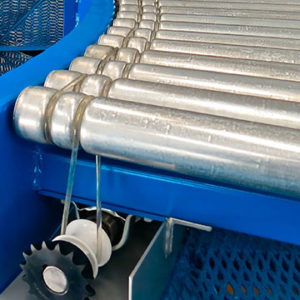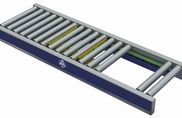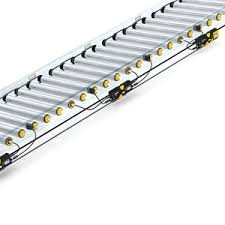Do you know the different types of roller conveyors available for your next project and the benefits and drawbacks of each one? If you’d like to know more, read on and this blog will explain all…
Powered roller conveyors fall into three common categories, depending on the way the rollers are driven.
Line-shaft conveyors
Line-shaft conveyors have been used for decades and are a ‘stalwart’ system – reliable and cost-effective. They offer a simple and effective means of moving light to medium weight boxes and totes.
Line-shaft roller conveyors are powered by an electric motor that rotates a shaft running longitudinally beneath the rollers. A series of spools are attached to the shaft and a polyurethane o-ring runs from each spool around a groove in the roller. As the motor turns the shaft, the shaft turns the spools and the o-rings, so the rollers also rotate.
Advantages
- Safe and effective method of moving totes and boxes
- Cost effective
- One drive motor can drive 15m-18m of straight roller conveyor
- Robust and easy to maintain
- Offers minimum pressure accumulation capability e.g products will make contact and push into each other if the line was stopped – but with a determined degree of impact that will not cause damage.
Disadvantages
- If a drive motor breaks down long sections of conveyor will stop turning (however conveyors will still turn for manual operation)
- This older technology can be a little noisy
- Parts-intensive and requires increased level of maintenance compared to other systems
- If accumulation is required e.g. before a transfer or decision point, additional equipment is needed, such as vertical blade stop (pneumatically-operated stop which would raise when a tote is to be stopped)
Belt-under-roller conveyors
Belt-under-roller conveyors are used where a high speed of throughput is required. They also offer a quieter mode of operation.
As the name suggests, these conveyors are driven by a belt that runs perpendicular to the rollers. This belt is driven by a motor. As the belt turns, friction is transmitted to the underside of the rollers and this turns the rollers.
Advantages
- Can achieve high speeds and throughput rates
- Less noisy
- Ideal for conveying medium weight loads over long distances – up to 30m from drive
- Able to create accumulation zones by dropping the belt.
Disadvantages
- If a drive motor breaks down long sections of conveyor will stop turning
- A degree of accumulation requires separate drives for bends etc
Motorised roller conveyors
Motorised rollers are being used more and more in conveyor systems, as their costs become more comparable with their alternatives. They offer greater flexibility and control over conveying processes and therefore can help business future-proof their processes.
Motorised roller conveyors are divided into small zones. In each zone at least one roller has an internal motor that turns it. Other rollers in the same zone are connected to it by o-rings, so that the motorised roller turns them too.
Motorised conveyors are ideal for zero pressure accumulation functionality. Because each zone of rollers is powered independently, the zones can be configured to run only when a package is present. The control system also makes it possible to allow a zone to remain free so a tote can be placed onto the conveyor without waiting for a gap.
Advantages
- 24-volt DC motors use less energy than the motors used to drive line-shaft or belt-under-roller conveyors
- If one motor develops a problem it will only stop one zone
- They provide less torque- making them safer
- Offer a very good drive capability
- Easier to maintain
- Provide true zero line pressure functionality, which allows totes to accumulate on a line without touching each other
- The control system provides a degree of inbuilt speed control. This allows for greater flexibility in positioning totes and moving through transfer areas, or onto and off spiral conveyors
- Ideal if future expansion is being considered as the system can easily be added to
Disadvantages
- More motorised rollers on the system compared to line-shaft conveyors – more complexity to system
- Offers lower speeds and throughput rates
- More expensive than other types of conveyor
If you would like some help specifying your next power conveyor system please get in touch with our team, who’d be happy to visit your site and suggest a solution.
Keymas are a conveyor systems and automation company. Contact us today to find out how we can help automate your business
Contact Us



